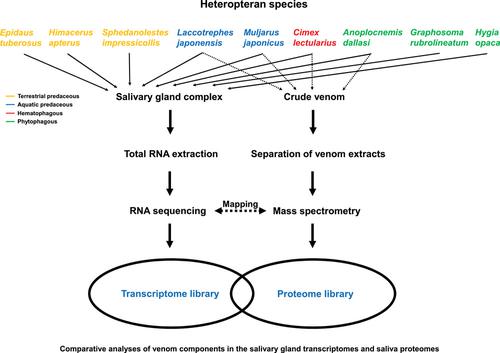当前位置:
X-MOL 学术
›
Insect Sci.
›
论文详情
Our official English website, www.x-mol.net, welcomes your
feedback! (Note: you will need to create a separate account there.)
Comparative analyses of the venom components in the salivary gland transcriptomes and saliva proteomes of some heteropteran insects
Insect Science ( IF 2.9 ) Pub Date : 2021-07-23 , DOI: 10.1111/1744-7917.12955 Kyungjae Andrew Yoon 1 , Woo-Jin Kim 2 , Seungki Lee 3 , Hee-Sun Yang 3 , Byoung-Hee Lee 3 , Si Hyeock Lee 1, 4
Insect Science ( IF 2.9 ) Pub Date : 2021-07-23 , DOI: 10.1111/1744-7917.12955 Kyungjae Andrew Yoon 1 , Woo-Jin Kim 2 , Seungki Lee 3 , Hee-Sun Yang 3 , Byoung-Hee Lee 3 , Si Hyeock Lee 1, 4
Affiliation

|
Salivary gland-specific transcriptomes of nine heteropteran insects with distinct feeding strategies (predaceous, hematophagous, and phytophagous) were analyzed and annotated to compare and identify the venom components as well as their expression profiles. The transcriptional abundance of venom genes was verified via quantitative real-time PCR. Hierarchical clustering of 30 representative differentially expressed venom genes from the nine heteropteran species revealed unique groups of salivary gland-specific genes depending on their feeding strategy. The commonly transcribed genes included a paralytic neurotoxin (arginine kinase), digestive enzymes (cathepsin and serine protease), an anti-inflammatory protein (cystatin), hexamerin, and an odorant binding protein. Both predaceous and hematophagous (bed bug) heteropteran species showed relatively higher transcription levels of genes encoding proteins involved in proteolysis and cytolysis, whereas phytophagous heteropterans exhibited little or no expression of these genes, but had a high expression of vitellogenin, a multifunctional allergen. Saliva proteomes from four representative species were also analyzed. All venom proteins identified via saliva proteome analysis were annotated using salivary gland transcriptome data. The proteomic expression profiles of venom proteins were in good agreement with the salivary gland-specific transcriptomic profiles. Our results indicate that profiling of the salivary gland transcriptome provides important information on the composition and evolutionary features of venoms depending on their feeding strategy.
中文翻译:

异翅目昆虫唾液腺转录组和唾液蛋白质组毒液成分的比较分析
分析和注释了九种具有不同摄食策略(捕食性、嗜血性和植食性)的异翅目昆虫的唾液腺特异性转录组,以比较和识别毒液成分及其表达谱。通过定量实时 PCR 验证毒液基因的转录丰度。来自九种异翅目物种的 30 个具有代表性的差异表达毒液基因的层次聚类揭示了唾液腺特异性基因的独特组,这取决于它们的摄食策略。常见的转录基因包括麻痹性神经毒素(精氨酸激酶)、消化酶(组织蛋白酶和丝氨酸蛋白酶)、抗炎蛋白(胱抑素)、六聚体和气味结合蛋白。捕食性和吸血性(臭虫)异翅目物种都表现出相对较高的编码参与蛋白水解和细胞溶解的蛋白质的基因转录水平,而植食性异翅目很少或没有这些基因的表达,但具有高表达的卵黄蛋白原,一种多功能过敏原。还分析了来自四个代表性物种的唾液蛋白质组。通过唾液蛋白质组分析鉴定的所有毒液蛋白均使用唾液腺转录组数据进行注释。毒液蛋白的蛋白质组表达谱与唾液腺特异性转录组谱非常一致。我们的研究结果表明,唾液腺转录组的分析提供了有关毒液组成和进化特征的重要信息,具体取决于它们的喂养策略。
更新日期:2021-07-23
中文翻译:

异翅目昆虫唾液腺转录组和唾液蛋白质组毒液成分的比较分析
分析和注释了九种具有不同摄食策略(捕食性、嗜血性和植食性)的异翅目昆虫的唾液腺特异性转录组,以比较和识别毒液成分及其表达谱。通过定量实时 PCR 验证毒液基因的转录丰度。来自九种异翅目物种的 30 个具有代表性的差异表达毒液基因的层次聚类揭示了唾液腺特异性基因的独特组,这取决于它们的摄食策略。常见的转录基因包括麻痹性神经毒素(精氨酸激酶)、消化酶(组织蛋白酶和丝氨酸蛋白酶)、抗炎蛋白(胱抑素)、六聚体和气味结合蛋白。捕食性和吸血性(臭虫)异翅目物种都表现出相对较高的编码参与蛋白水解和细胞溶解的蛋白质的基因转录水平,而植食性异翅目很少或没有这些基因的表达,但具有高表达的卵黄蛋白原,一种多功能过敏原。还分析了来自四个代表性物种的唾液蛋白质组。通过唾液蛋白质组分析鉴定的所有毒液蛋白均使用唾液腺转录组数据进行注释。毒液蛋白的蛋白质组表达谱与唾液腺特异性转录组谱非常一致。我们的研究结果表明,唾液腺转录组的分析提供了有关毒液组成和进化特征的重要信息,具体取决于它们的喂养策略。


















































 京公网安备 11010802027423号
京公网安备 11010802027423号